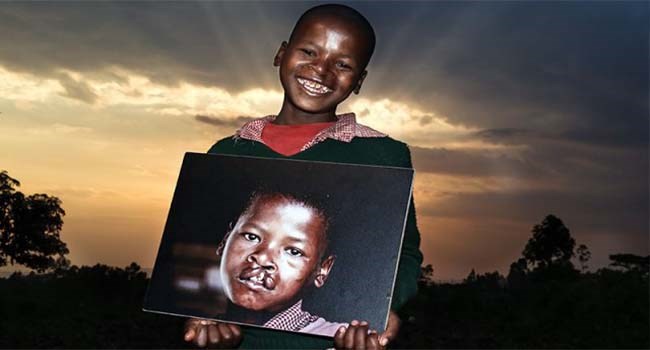
Sunday October 9, 2022
 Smile Train put a smile on Dennis face/Courtesy of Smile Train
Smile Train put a smile on Dennis face/Courtesy of Smile Train
NAIROBI, Kenya Oct 9 – The World Smile Day, Smile Train and the Institute for Health Metrics and Evaluation (IHME) at the University of Washington’s School of Medicine have released a new report showing that one in three children in Africa and South Asia is malnourished, and that number is exponentially higher for children with clefts in those regions.
According to the report, the highest malnutrition rates tied to clefts traversed Somalia to Mali to include Democratic Republic of the Congo, Ethiopia, Nigeria, Sudan, South Sudan. Globally, nearly half of cleft-related malnutrition deaths in children under 5 could be prevented with access to adequate nutrition and surgical treatment.
The report provides a first-of-its-kind look at the devastating impact of orofacial clefts over two decades, 2000 to 2020. Clefts occur when certain body parts and structures do not fuse together during fetal development and can cause difficulties eating, breathing, hearing, and speaking. The report synthesized two sets of data, one from Smile Train Express and the other IHME’s Global Burden of Disease Modeling demographic group. After pairing and modifying the datasets for alignment, researchers used two meta-regression models to calculate results.
Key findings include:
- In Sub-Saharan Africa, North Africa, and the Middle East, for the period 2000-2022, it is estimated that almost half of malnutrition-related deaths in children with clefts could have been prevented with timely access to adequate cleft treatment and support.
- If children with clefts did not experience higher rates of undernutrition, as many as 21,000 deaths worldwide could be averted with intervention.
- Children with clefts in North Africa and the Middle East are more than twice as likely to be malnourished compared to all children.
- In Sub-Saharan Africa, children with clefts are almost twice as likely to be malnourished compared to their peers without clefts.
- Over the past 20 years, the number of children born with clefts under the age of 5 has failed to decline significantly.
- Compared to underweight children, underweight children living with clefts endure a heavier burden of poor nutrition. They face a higher risk of undernutrition and other potentially life-threatening conditions.
- Almost half of malnutrition-related deaths in children with clefts in Sub-Saharan Africa could be prevented with access to adequate cleft treatment and support.
“By combining the forces of Smile Train’s more than 1.5 million surgical records in the Smile Train Express database, including a wealth of nutrition data, and IHME’s comprehensive set of health estimates, we now know more about clefts than ever before,” says Nicholas Kassebaum, MD, an associate professor at the IHME and a lead author of the study. “We hope that this is a call to action for global health leaders to take further action against undernutrition in children with clefts.”
“Malnutrition across Africa is a crisis that has been exacerbated by global calamities such as the COVID-19 pandemic, climate change, conflict and over-dependence on rain-fed agriculture. Without the right nutrition, children with clefts are not optimized for surgery thus risk death before their first birthday and growing up with untreated cleft creates an obstacle to their social and economic wellbeing. It is our hope that this valuable data will help inform government policy and prioritize interventions through a more strategic and multi-disciplinary approach towards maternal and child health,” said Mrs. Nkeiruka Obi, Smile Train Vice-President and Regional Director for Africa.